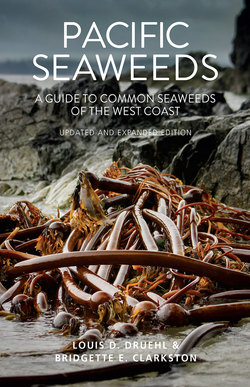Читать книгу Pacific Seaweeds - Louis Druehl - Страница 48
На сайте Литреса книга снята с продажи.
ОглавлениеPacific Seaweeds
48 | Seagrasses
Description
Phyllospadix has bright green blades usually less than 4 mm (0.16 in) wide. Phyllospadix scouleri and P. serrulatus have blades 2–4 mm (0.08–0.16 in) wide and usually less than 1 m (3 ft) long. They may be distinguished from each other by the presence of transparent teeth along the margin of young P. serrulatus leaves, which can be seen with a magnifying glass. The third species, P. torreyi, has blades 2 mm (0.08 in) wide or narrower, and up to 3 m (10 ft) long.
As flowering plants have adapted their reproduction to the marine environment, some curious morphological features have evolved. Seagrass pollen may occur in a variety of strange shapes: thread-like, spherical, boomerang-shaped. Joe Ackerman (University of Guelph) has studied pollination in sea-grasses having filamentous (thread-like) pollen.
This pollen tumbles through the water, sweeping large areas, thus enhancing its chance of encountering the stigma (the pollen-receptive part of the female flower). Following fertilization, the seagrass seed and surrounding seed fruit develop and then are released. Hooks on the fruit/seed combo are adapted to catch effectively on particular seaweed morphologies. Once snared, the seed germinates and sends down roots to secure the plant to the substrate.
Habitat & Distribution
Phyllospadix is distributed from Alaska to Mexico. The plants are rooted (attached) to solid rock. A covering of sediments may obscure this attach-ment. Paul G. Harrison (University of British Columbia) has observed surf-grass roots buried deeper than 50 cm (20 in) in accumulated sediments.
Phyllospadix scouleri and P. serrulatus grow in wave-exposed areas in the lower intertidal and subtidal regions, and in tide pools. Phyllospadix torreyi is found intertidally and subtidally, below P. scouleri, and is frequently found in channels and back eddies, where sand accumulates.
Phyllospadix scouleri (surfgrass) with seed pod.
